Smoking sausage and other cured meats is a true art form requiring patience, expertise, and precision. The mouth-watering flavors and aromas of smoked meats are achieved through a careful process that begins with selecting the right meat and ingredients and continues through to the smoking, aging, and serving of the final product. Whether you’re an experienced smoker or a beginner, mastering this art can lead to incredible culinary experiences that will impress and satisfy your taste buds.
Choosing the Right Meat and Ingredients
Choosing the right meat and ingredients is crucial in achieving exceptional results when smoking sausage and other cured meats. Here are some tips to help you select high-quality meat and source the right ingredients for curing:
- Meat selection: The best meats for smoking are ones with higher fat content, such as pork butt, beef brisket, and chicken thighs. Avoid lean meats, as they tend to dry out during the smoking process.
- Quality: Choose meat that is fresh and has good marbling. Look for a bright color and avoid meat with any discoloration or odor.
- Ingredients: The key ingredients for curing meats include salt, sugar, and nitrates or nitrites. These ingredients are essential for preserving the meat and giving it its distinct flavor. It is important to use high-quality ingredients to ensure the best results.
- Sourcing: Look for ingredients that are natural and free of additives or preservatives. Consider purchasing from local suppliers or farmers markets for the freshest options.
By selecting the right meat and ingredients, you can set the foundation for great-tasting smoked sausage and other cured meats.
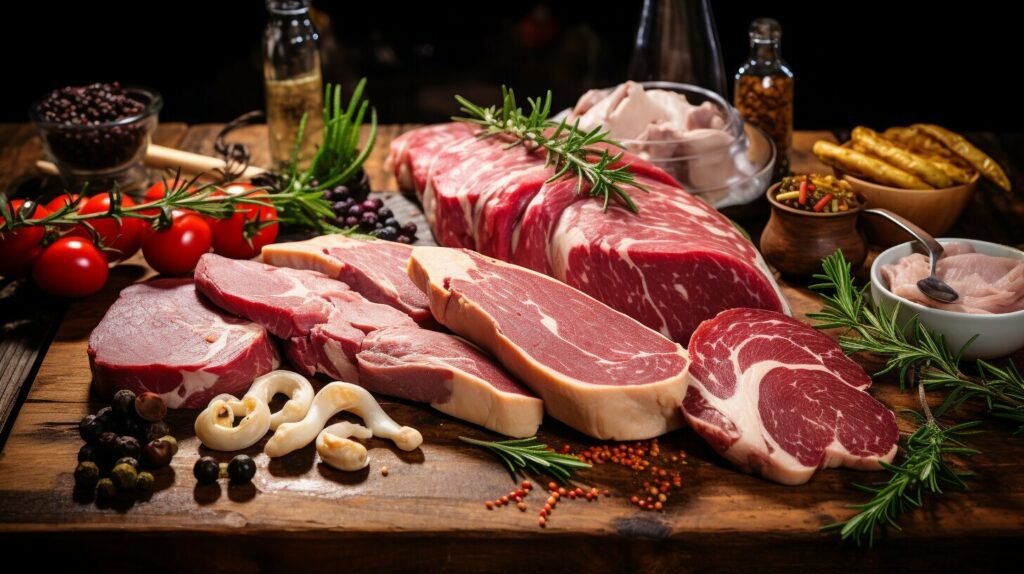
Preparing the Meat for Smoking
Before you start smoking your meat, it’s important to properly prepare it. This includes trimming excess fat, marinating or brining, and seasoning. Proper preparation will not only enhance the flavor and texture of your meat, but it will also help prevent bacterial growth during the smoking process.
Trimming excess fat: It’s important to trim away any excess fat from your meat before smoking. This not only makes the meat healthier, but it also prevents the fat from becoming rancid during the smoking process. Use a sharp knife to trim off any visible fat or connective tissue.
Marinating or brining: Marinating or brining your meat before smoking can help infuse it with additional flavor. If you’re using a marinade, be sure to pat the meat dry before smoking to remove any excess liquid. If you’re using a brine, rinse the meat with cold water before smoking to remove any excess salt.
Seasoning: Seasoning your meat is a crucial step in preparing it for smoking. A dry rub is a popular seasoning option, as it allows the meat to form a flavorful crust during the smoking process. For a basic dry rub, combine salt, pepper, paprika, garlic powder, and onion powder in a bowl. Rub the seasonings onto the meat, making sure it’s evenly coated. If you’re looking for a more complex flavor profile, consider adding other seasonings such as cumin, chili powder, or brown sugar.
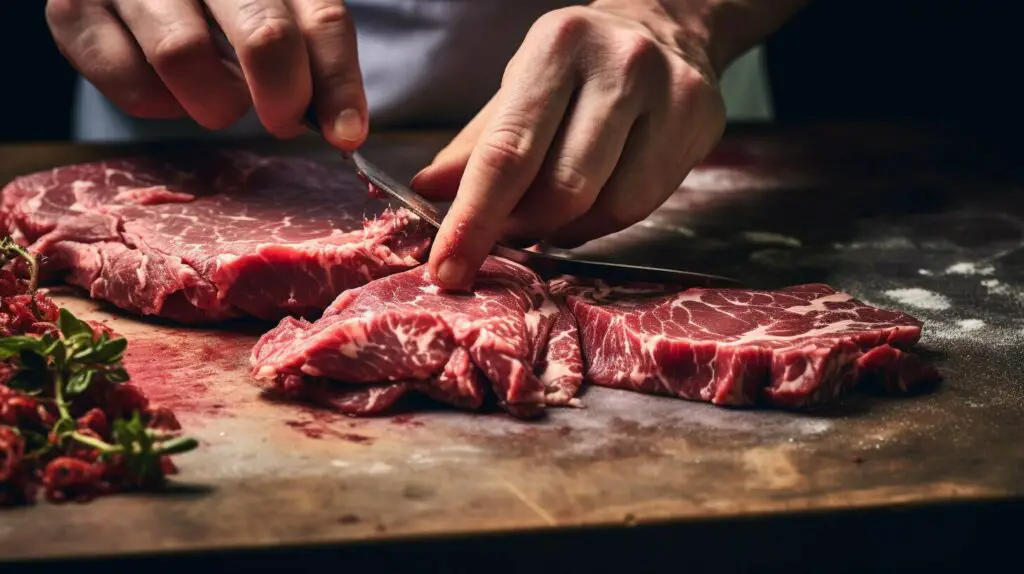
Expert tip:
“When it comes to seasoning your meat, less is often more. Be sure to taste as you go and adjust the seasonings accordingly.”
Understanding Smoking Techniques
Smoking is a technique that infuses flavor into meat while preserving it. There are several smoking methods, each with its unique benefits and challenges. Understanding these techniques is crucial in ensuring that you achieve the desired results.
Hot Smoking
Hot smoking involves cooking meat at temperatures between 225°F and 250°F. This method results in fully cooked meat with a smoky flavor. It is the most common smoking method and is suitable for sausages, ham, and bacon.
To hot smoke meats, prepare your smoker by bringing it to the desired temperature. Place the meats on the cooking grates, and wait for the internal temperature to reach the recommended level. It is essential to use a meat thermometer to ensure that your meat is fully cooked, with no risk of foodborne illness.
Cold Smoking
Cold smoking is the process of smoking meat at temperatures between 68°F and 86°F. This method does not cook the meat but infuses smoke flavor. Cold smoking is ideal for meats that require further cooking, such as salmon, cheese, and bacon.
To cold smoke meats, place the meat on a separate rack from the smoker’s heat source, and close the unit’s vents to keep the temperature low. Use a separate smoking device or generator to get smoke into the smoker. The process can take several hours or days, depending on the desired level of smokiness.
Combination Smoking
Combination smoking is a hybrid of hot and cold smoking. This method involves exposing the meat to both hot and cold smoking to achieve a unique flavor profile. Combination smoking is ideal for larger cuts of meat, such as brisket, pork shoulder, or turkey.
The first step in combination smoking is cold smoking the meat and then finishing it with hot smoking. This method allows the smoke flavor to penetrate the meat while also producing a crisp outer layer.

Flavors and Seasonings for Cured Meats
When it comes to smoking sausage and other cured meats, flavors and seasonings play an essential role in delivering a delicious end result. By enhancing the natural flavors of the meat and adding complementary notes, you can create a memorable culinary experience.
One popular way to add flavors to cured meats is through dry rubs. These are spice blends that are applied to the meat before smoking, allowing the flavors to penetrate deeply. Common dry rub ingredients include salt, sugar, paprika, garlic powder, and black pepper. You can experiment with different ratios and ingredients to find a blend that suits your taste.
| Flavor Profile | Ingredients |
|---|---|
| Sweet | Brown sugar, cinnamon, nutmeg, allspice |
| Smoky | Paprika (smoked or regular), cumin, chili powder |
| Savory | Garlic powder, onion powder, thyme, rosemary |
Another technique for seasoning cured meats is brining. This involves soaking the meat in a saltwater solution, which not only adds flavor but also helps to tenderize the meat. You can customize your brine by adding ingredients like sugar, herbs, and spices.
Marinades are another way to infuse flavor into cured meats. These are liquid mixtures that typically include an acid (such as vinegar or citrus juice) and herbs and spices. Marinades work best with thinner cuts of meat, as the liquid can penetrate the meat more easily.

Whatever seasoning technique you choose, be sure to avoid over-seasoning or using incompatible flavors. Keep in mind that the flavors will intensify during the smoking process, so a little bit can go a long way. With practice, you’ll develop a feel for the right balance of flavors and seasonings to achieve the perfect taste.
Essential Equipment for Smoking
When it comes to smoking sausage and other cured meats, having the right equipment is essential for success. Here are some of the key tools you will need:
| Equipment | Description |
|---|---|
| Smoker | A smoker is the most important tool for smoking meats. There are many types of smokers available on the market, such as electric, gas, charcoal, and wood-fired. Choose the one that suits your needs and budget. |
| Thermometer | Use a reliable digital thermometer to monitor the temperature inside the smoker and the internal temperature of the meat. |
| Wood Chips | Wood chips are used to create smoke and impart flavor to the meat. Different types of wood chips produce different flavors. Choose from hickory, mesquite, apple, cherry, pecan, or any other flavor of your liking. |
| Meat Hooks | Meat hooks are used to hang the meat inside the smoker. This allows the smoke to circulate around the meat evenly and ensures that it cooks uniformly. |
| Drip Pan | A drip pan is used to collect any excess drippings from the meat. It is important to keep the smoker clean and prevent flare-ups. |
| Aluminum Foil | Aluminum foil is used to wrap the meat to prevent it from drying out and to keep the smoke and flavor locked in. |
With these tools, you’ll be ready to smoke sausage and other cured meats like a pro. Now that you know what you need, let’s move on to the smoking process itself.
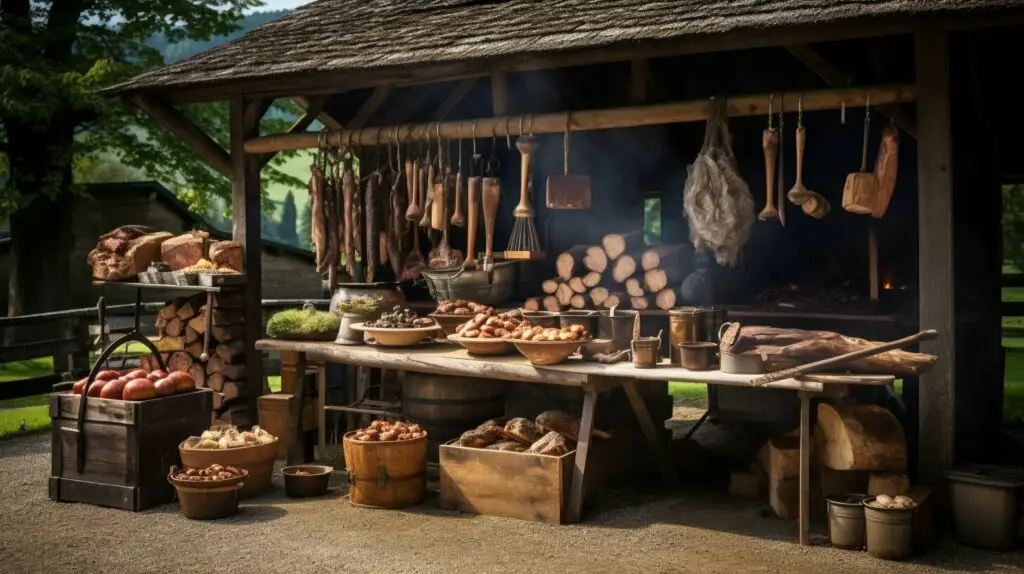
The Smoking Process
Now that you have prepared your meat and selected the right smoking method, it’s time to start the smoking process. Follow these steps to ensure delicious and perfectly smoked sausage and other cured meats:
- Fill the smoker with wood chips: Depending on the smoking method you are using, fill the smoker with the appropriate type of wood chips. The smoke will infuse with the meat and give it flavor, so choose your wood chips carefully. Experiment with different types of wood to find your flavor.
- Place the meat in the smoker: Place your prepared meat in the smoker on the rack. Close the smoker and make sure the temperature is set to the right level. Use a thermometer to measure the temperature and adjust as necessary.
- Monitor the temperature: The temperature of the smoker should remain consistent throughout the smoking process. Ensure that the temperature does not fluctuate too much, as this can impact the quality of the final product. Adjust the temperature if necessary.
- Ensure smoke flow: The smoke should flow freely around the meat inside the smoker. Check that the vents are open and the smoke is flowing correctly. Keep an eye on the smoker to ensure good smoke flow throughout the process.
- Check the meat: After a few hours, check the meat to see how it is progressing. Depending on the meat and the smoking method, it may take several hours to smoke the meat to perfection. Use a thermometer to ensure that the meat is cooked to the correct temperature.
Remember, smoking sausage and other cured meats is an art that takes practice to perfect. Keep experimenting with different smoking techniques until you find the perfect combination for your tastes.

Storing and Aging Cured Meats
After smoking and curing your meat, it’s important to properly store and age it to maximize flavor and safety. Here are some tips for storing and aging cured meats:
| Tip | Explanation |
|---|---|
| Temperature control | Cured meats should be stored at a temperature between 34-40°F to prevent the growth of harmful bacteria. |
| Humidity levels | The ideal humidity level for cured meats is between 70-80%. This helps prevent the meat from drying out and developing a tough texture. |
| Shelf life | Cured meats can last for several months if stored properly. However, it’s important to check for any signs of spoilage before consuming. |
When it comes to aging cured meats, the length of time depends on personal preference and the type of meat being aged. Some meats, such as salami, can be aged for several weeks to develop a complex flavor profile. Other meats, such as bacon, may only need a few days.
It’s important to regularly check on your cured meats during the aging process to ensure they are not developing any mold or off-putting flavors. If you notice any signs of spoilage, it’s best to discard the meat.
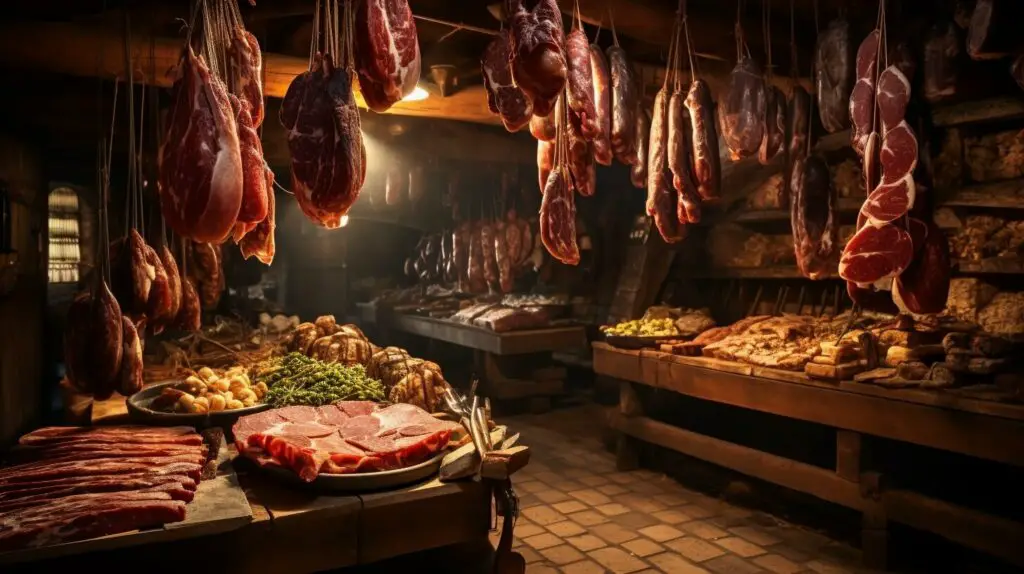
By following these tips for storing and aging your cured meats, you can ensure that they stay fresh and delicious for as long as possible.
The Art of Serving and Enjoying Smoked Meats
Smoked meats are versatile and can be enjoyed in many different ways. Whether you’re serving a crowd or simply enjoying a meal at home, there are plenty of options for enjoying your delicious smoked meats. Here are some tips to help maximize the flavor and enjoyment of your cured meats.
Pairing Options
Smoked sausage and other cured meats pair well with a wide variety of foods and beverages. For a classic pairing, serve your smoked meats with hearty sides such as baked beans or potato salad. For a lighter option, pair smoked meats with a mixed greens salad or grilled vegetables. Don’t forget about the drinks! Smoked meats pair well with beer, wine, or even a classic sweet tea.
Creative Recipes
Looking to get creative with your smoked meats? Try incorporating them into unique recipes that showcase their bold and complex flavors. Some ideas include smoked sausage and cheese dip, smoked meat tacos, or even smoked meat pizza. The possibilities are endless!
Serving Suggestions
When serving your smoked meats, there are a few things to keep in mind. First, be sure to slice your cured meats thinly for optimal texture and flavor. If serving a crowd, consider setting up a DIY sandwich bar with various condiments and toppings to customize each sandwich to individual tastes. Lastly, don’t forget about the presentation! A beautiful charcuterie board featuring a variety of smoked meats, cheeses, and crackers is always a crowd-pleaser.
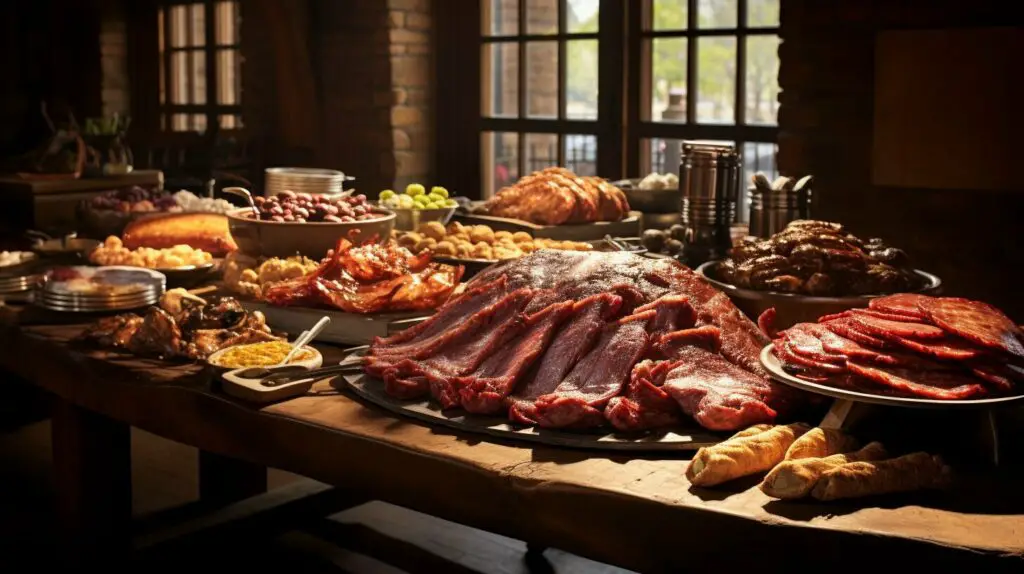
With these tips in mind, you’re well on your way to enjoying the deliciousness of smoked sausage and other cured meats. Whether you prefer them sliced thin, topped with your favorite condiments, or incorporated into creative recipes, there’s no wrong way to enjoy these flavorful treats.
The Art of Smoking Sausage and Other Cured Meats: Frequently Asked Questions
Smoking sausage and other cured meats can be both an art and a science. As with any culinary pursuit, there are many questions that can arise during the process. Here are some of the most frequently asked questions about smoking sausage and other cured meats:
What types of wood are best for smoking?
There are many types of wood that work well for smoking sausage and other cured meats, each with its own unique flavor. Some popular choices include hickory, mesquite, applewood, and cherry. The type of wood you choose will largely depend on personal preference and the type of meat you are smoking.
What is the ideal temperature for smoking sausage?
The ideal temperature for smoking sausage is between 165°F and 175°F. This temperature range ensures that the sausage is fully cooked and safe to eat, while also allowing for the development of a rich, smoky flavor.
How long should I smoke my meat?
The length of time you should smoke your meat will depend on several factors, including the type of meat, the thickness of the cuts, and the smoking method you are using. As a general rule of thumb, most meats will need to be smoked for several hours to fully develop their flavor.
How do I know when my meat is done?
The best way to determine if your meat is done is to use a meat thermometer. Insert the thermometer into the thickest part of the meat and make sure it reaches the appropriate temperature for the type of meat you are cooking. You can also check for visual cues, such as the meat pulling away from the bone, to ensure that it is fully cooked.
Can I smoke meat in a charcoal grill?
Yes, you can smoke meat in a charcoal grill. To do so, you will need to set up your grill for indirect heat by placing the coals on one side and the meat on the other. You will also need to add smoking wood to the coals to create smoke.
How long can I store cured meats?
The length of time you can store cured meats will depend on several factors, including the type of meat, the curing method you used, and the storage conditions. In general, most cured meats will last for several weeks to several months if stored properly.
What are some creative ways to serve smoked meats?
Smoked meats can be served in a variety of creative ways, including in sandwiches, salads, and pasta dishes. They can also be used as a flavorful addition to soups and stews. Experiment with different recipes to find the perfect way to showcase the rich, smoky flavor of your cured meats.
Can I freeze smoked meats?
Yes, you can freeze smoked meats. However, it is important to wrap them tightly in plastic wrap or aluminum foil before freezing to prevent freezer burn. Thaw frozen smoked meats in the refrigerator before reheating or serving.
What is the difference between hot smoking and cold smoking?
Hot smoking involves smoking meat at a temperature of around 225°F, which fully cooks the meat while also infusing it with smoke flavor. Cold smoking, on the other hand, involves smoking meat at a temperature of 90°F or below, which does not cook the meat but instead imparts a smoky flavor. Cold smoking is often used for cured meats and fish.




